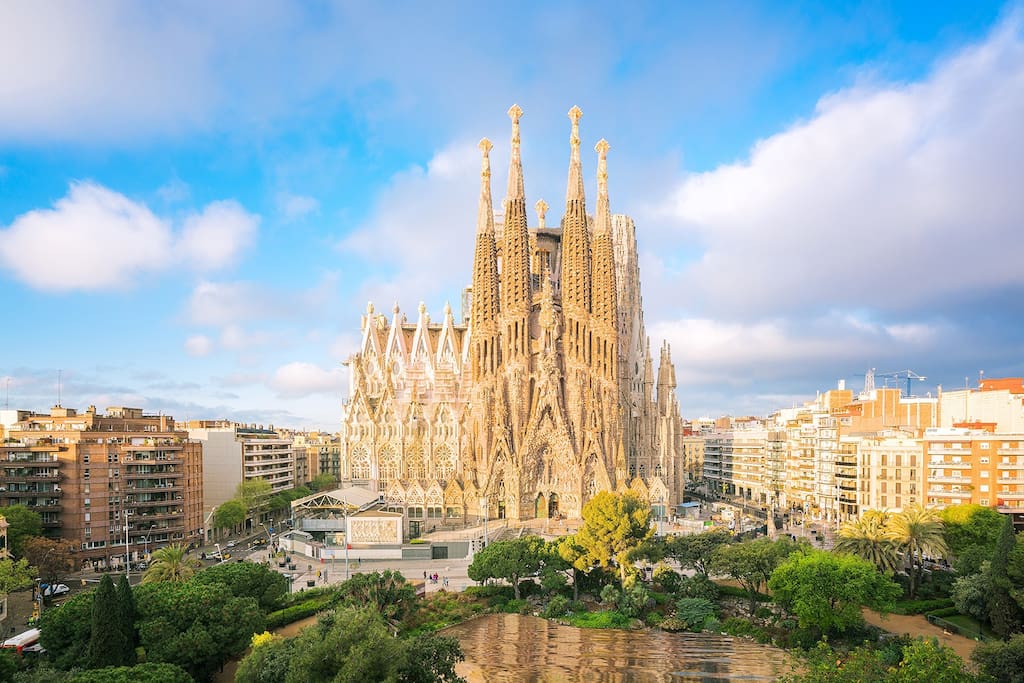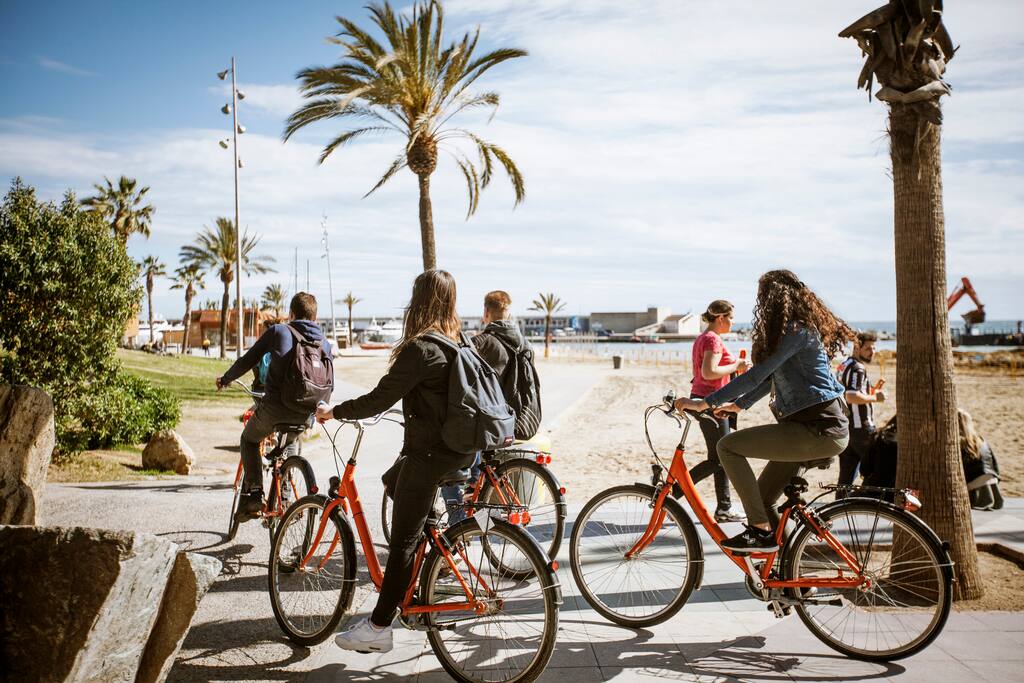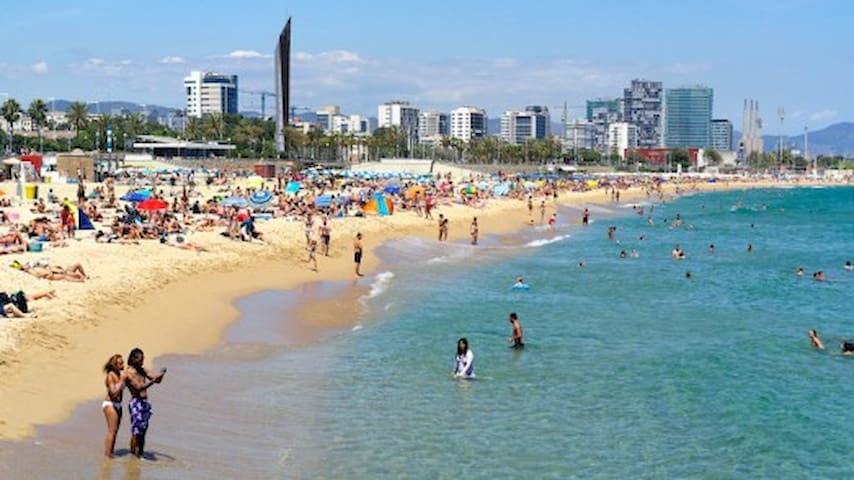Nearby
La Mama Restaurant
Carretera Parets a BiguesCatalan food restaurant in a 18th century house
สถานีวิ่งซิกกิ้วเดอคาตาลูเนีย
km. 2 Carretera GranollersFormula 1, Moto GP and Superbike circuit
The hot springs have been exploited since Roman times, and the remnants of the Roman baths and other Roman buildings can still be seen. The source of la Font del Lleó ("Lion Springs") in the main square emerges at more than 70 °C (158 °F). The town conserves parts of its medieval fortifications and the Torre de la Presó (prison). The hermitage of la Mare de Déu del Remei dates from the sixteenth century, as does the church of Santa Maria with its baroque entrance. The roman church of Sant Sebastià de Montmajor, in the village of the same name at the extreme north-west of the municipality, is particularly well preserved.
17 คนท้องถิ่นแนะนำ
Caldes de Montbui
The hot springs have been exploited since Roman times, and the remnants of the Roman baths and other Roman buildings can still be seen. The source of la Font del Lleó ("Lion Springs") in the main square emerges at more than 70 °C (158 °F). The town conserves parts of its medieval fortifications and the Torre de la Presó (prison). The hermitage of la Mare de Déu del Remei dates from the sixteenth century, as does the church of Santa Maria with its baroque entrance. The roman church of Sant Sebastià de Montmajor, in the village of the same name at the extreme north-west of the municipality, is particularly well preserved.
Barcelona city
Meier embraced the difficult task of creating a building that would ultimately display a variety of contemporary artworks that were unknown to him at the time of design. The choice to build the museum in the Plaça dels Ángels is consistent with Meier’s vision to situate the building amongst some of Barcelona’s oldest streets and buildings, in addition to revamping the public space of the Raval.
After the completion of the $35 million construction, local media referred to the museum as “the pearl” amongst the old architecture and narrow streets just a few blocks from Gothic center of Barcelona.The building’s architectural style has strong references to Modernism. The large (120 by 35 meters) white building has much of its southern elevation glazed, providing the visitor with views across the plaza, and allowing for an abundance of natural light to illuminate the interior galleries. The museum has three main galleries, which can be subdivided, as well as five smaller galleries, one of which is in a tower.
Collection
The permanent collection of around 5,000 works(up from 1,100 works at the time of the museum's opening in 1995) dates from the mid-20th century onward. There are three periods of modern art represented: the first one covers the forties to the sixties; the second spans the sixties and seventies; the third period is contemporary. The collections focus on post-1945 Catalan and Spanish art, although some International artists are also represented
1224 คนท้องถิ่นแนะนำ
พิพิธภัณฑ์ศิลปะร่วมสมัยบาร์เซโลนา
1 Plaça dels ÀngelsMeier embraced the difficult task of creating a building that would ultimately display a variety of contemporary artworks that were unknown to him at the time of design. The choice to build the museum in the Plaça dels Ángels is consistent with Meier’s vision to situate the building amongst some of Barcelona’s oldest streets and buildings, in addition to revamping the public space of the Raval.
After the completion of the $35 million construction, local media referred to the museum as “the pearl” amongst the old architecture and narrow streets just a few blocks from Gothic center of Barcelona.The building’s architectural style has strong references to Modernism. The large (120 by 35 meters) white building has much of its southern elevation glazed, providing the visitor with views across the plaza, and allowing for an abundance of natural light to illuminate the interior galleries. The museum has three main galleries, which can be subdivided, as well as five smaller galleries, one of which is in a tower.
Collection
The permanent collection of around 5,000 works(up from 1,100 works at the time of the museum's opening in 1995) dates from the mid-20th century onward. There are three periods of modern art represented: the first one covers the forties to the sixties; the second spans the sixties and seventies; the third period is contemporary. The collections focus on post-1945 Catalan and Spanish art, although some International artists are also represented
"National Art Museum of Catalonia"), abbreviated as MNAC, is the national museum of Catalan visual art located in Barcelona, Catalonia, Spain. Situated on Montjuïc hill at the end of Avinguda de la Reina Maria Cristina, near Pl Espanya, the museum is especially notable for its outstanding collection of romanesque church paintings, and for Catalan art and design from the late 19th and early 20th centuries, including modernisme and noucentisme. The museum is housed in the Palau Nacional, a huge, Italian-style building dating to 1929. The Palau Nacional, which has housed the Museu d'Art de Catalunya since 1934, was declared a national museum in 1990 under the Museums Law passed by the Catalan Government. That same year, a thorough renovation process was launched to refurbish the site, based on plans drawn up by the architects Gae Aulenti and Enric Steegmann, who were later joined in the undertaking by Josep Benedito. The Oval Hall was reopened in 1992 on the occasion of the Olympic Games, and the various collections were installed and opened over the period from 1995 (when the Romanesque Art section was reopened) to 2004. The Museu Nacional d'Art de Catalunya (Museu Nacional) was officially inaugurated on 16 December 2004.[1] It is one of the largest museums in Spain.
861 คนท้องถิ่นแนะนำ
Museu Nacional d'Art de Catalunya - MNAC
s/n Parc de Montjuïc"National Art Museum of Catalonia"), abbreviated as MNAC, is the national museum of Catalan visual art located in Barcelona, Catalonia, Spain. Situated on Montjuïc hill at the end of Avinguda de la Reina Maria Cristina, near Pl Espanya, the museum is especially notable for its outstanding collection of romanesque church paintings, and for Catalan art and design from the late 19th and early 20th centuries, including modernisme and noucentisme. The museum is housed in the Palau Nacional, a huge, Italian-style building dating to 1929. The Palau Nacional, which has housed the Museu d'Art de Catalunya since 1934, was declared a national museum in 1990 under the Museums Law passed by the Catalan Government. That same year, a thorough renovation process was launched to refurbish the site, based on plans drawn up by the architects Gae Aulenti and Enric Steegmann, who were later joined in the undertaking by Josep Benedito. The Oval Hall was reopened in 1992 on the occasion of the Olympic Games, and the various collections were installed and opened over the period from 1995 (when the Romanesque Art section was reopened) to 2004. The Museu Nacional d'Art de Catalunya (Museu Nacional) was officially inaugurated on 16 December 2004.[1] It is one of the largest museums in Spain.
คาซา มิลา
92 Pg. de GràciaLa Sagrada Cerveseria
16 Plaça Sagrada FamíliaLa Barceloneta
หาดบอกาเทลล์
Catalonia country
The monastery is 48 kilometres (30 mi) northwest of Barcelona, and can be reached by road, train or cable car. The abbey's train station, operated by FGC, is the terminus of a rack railway connecting with Monistrol, and two funiculars, one connecting with Santa Cova (a shrine and chapel lower down the mountain) and the other connecting with the upper slopes of the mountain. At 1,236 metres (4,055 ft) above the valley floor, Montserrat is the highest point of the Catalan lowlands, and stands central to the most populated part of Catalonia. Montserrat's highest point, Sant Jeroni, can be reached by footpaths leading from the monastery. From Sant Jeroni, almost all of Catalonia can be seen, and on a clear day the island of Mallorca is visible.
115 คนท้องถิ่นแนะนำ
Montserrat
The monastery is 48 kilometres (30 mi) northwest of Barcelona, and can be reached by road, train or cable car. The abbey's train station, operated by FGC, is the terminus of a rack railway connecting with Monistrol, and two funiculars, one connecting with Santa Cova (a shrine and chapel lower down the mountain) and the other connecting with the upper slopes of the mountain. At 1,236 metres (4,055 ft) above the valley floor, Montserrat is the highest point of the Catalan lowlands, and stands central to the most populated part of Catalonia. Montserrat's highest point, Sant Jeroni, can be reached by footpaths leading from the monastery. From Sant Jeroni, almost all of Catalonia can be seen, and on a clear day the island of Mallorca is visible.
Girona is a popular destination for tourists and Barcelona day-trippers. The old town stands on the steep hill of the Capuchins to the east of the river Onyar, while the more modern section stands on the plains to the west.
Cathedral
The ancient cathedral, which stood on the site of the present one, was used by the Moors as a mosque, and after their final expulsion was either entirely remodelled or rebuilt. The present edifice is one of the most important monuments of the school of the Majorcan architect Jaume Fabre and an excellent example of Catalan Gothic architecture. It is approached by eighty-six steps. An aisle and chapels surround the choir, which opens by three arches into the nave, of which the pointed stone vault is the widest in Christendom (22 meters). Among its interior decorations is a retable which is the work of the Valencian silversmith Pere Bernec. It is divided into three tiers of statuettes and reliefs, framed in canopied niches of cast and hammered silver. A gold and silver altar-frontal was carried off by the French in 1809. The cathedral contains the tombs of Ramon Berenger and his wife.
Old fortifications
The old fortifications are another popular sight. Historically, these have played a vital role in protecting Girona from invaders for hundreds of years. The city wall of the old town was an important military construction built in Roman times in the 1st century BC. It was thoroughly rebuilt under the reign of Peter III the Ceremonious in the second half of the 14th century. The Roman wall was used as a foundation. At the start of the 16th century, the wall was absorbed in the city. The walled precinct lost its military value. Bit by bit, the wall was degrading, as parts were gradually altered from the inside and the outside. The walls and lookout towers that make up these fortifications are split in two - a small section in the north of the old town and a much larger section to the east and south. It is possible to walk the walls and climb the towers, where visitors can enjoy panoramic views of Girona and the surrounding countryside
391 คนท้องถิ่นแนะนำ
Girona
Girona is a popular destination for tourists and Barcelona day-trippers. The old town stands on the steep hill of the Capuchins to the east of the river Onyar, while the more modern section stands on the plains to the west.
Cathedral
The ancient cathedral, which stood on the site of the present one, was used by the Moors as a mosque, and after their final expulsion was either entirely remodelled or rebuilt. The present edifice is one of the most important monuments of the school of the Majorcan architect Jaume Fabre and an excellent example of Catalan Gothic architecture. It is approached by eighty-six steps. An aisle and chapels surround the choir, which opens by three arches into the nave, of which the pointed stone vault is the widest in Christendom (22 meters). Among its interior decorations is a retable which is the work of the Valencian silversmith Pere Bernec. It is divided into three tiers of statuettes and reliefs, framed in canopied niches of cast and hammered silver. A gold and silver altar-frontal was carried off by the French in 1809. The cathedral contains the tombs of Ramon Berenger and his wife.
Old fortifications
The old fortifications are another popular sight. Historically, these have played a vital role in protecting Girona from invaders for hundreds of years. The city wall of the old town was an important military construction built in Roman times in the 1st century BC. It was thoroughly rebuilt under the reign of Peter III the Ceremonious in the second half of the 14th century. The Roman wall was used as a foundation. At the start of the 16th century, the wall was absorbed in the city. The walled precinct lost its military value. Bit by bit, the wall was degrading, as parts were gradually altered from the inside and the outside. The walls and lookout towers that make up these fortifications are split in two - a small section in the north of the old town and a much larger section to the east and south. It is possible to walk the walls and climb the towers, where visitors can enjoy panoramic views of Girona and the surrounding countryside
Costa Brava
North coast of Catalonia, by AP7 highway
PortAventura World
Km 2 Av. Pere MolasMontseny
Vall de Núria Ski Resort
Caldes d'Estrac
Rupit






